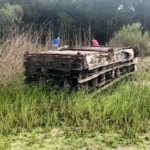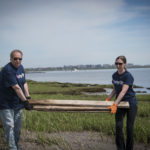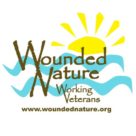 Many of us associate the smell of creosote with fond memories of fishing off a pier, lining up to ride a ferry or train, or enjoying a beach fire with friends. Creosote has been around for a long time, so why is Wounded Nature-Working Veterans so intent on removing it from critical coastal areas and marine habitats?
Many of us associate the smell of creosote with fond memories of fishing off a pier, lining up to ride a ferry or train, or enjoying a beach fire with friends. Creosote has been around for a long time, so why is Wounded Nature-Working Veterans so intent on removing it from critical coastal areas and marine habitats?
In most countries, creosote is either banned entirely or its use is highly regulated these days, but it was widely used for nearly 100 years as a wood preservative, mainly on wood that was placed in contact with the ground or water such as railroad ties, dock and pier pilings, beams and decking.
As if the creosote wasn’t bad enough, toxic chemicals like arsenic and DDT were very effective for keeping wood-damaging insects and fungi out of treated wood. Railroads and utility companies were permitted to use highly concentrated amounts of those pesticides under the guise of “Public Safety” and were given special exemptions to protect their uses of these toxins. But now thousands of tons of creosote and pesticide-soaked wood pilings and debris litter tidal marshes and critical coastal areas all over the world.
Current research tells us that toxic chemicals leach out into the surrounding environment and are a danger to the health of animals and people. Evidence shows that the toxicity of creosote causes damage to the eggs of small fish and other organisms that are the foundation of the food chain, and essential to fish, birds, and other wildlife.
Several studies have provided a clear reason to remove as much creosote as possible from our marine waters. Coal tar creosote is the most common of the mixes, and may be comprised of many as 10,000 chemicals. The primary chemicals of concern are polycyclic aromatic hydrocarbons (PAHs), phenols, and creosols because of their harmful health effects. Of these three, PAHs are the most common.
chemicals. The primary chemicals of concern are polycyclic aromatic hydrocarbons (PAHs), phenols, and creosols because of their harmful health effects. Of these three, PAHs are the most common.
The chemicals in creosote break down in water very slowly. In aquatic environments, they tend to cling to particles such as sediments where many contaminants collect. The chemicals vary widely in toxicity. For some organisms, they are acutely toxic. For others, such as fish, birds, amphibians, and mammals, they can cause cancer, mutation, or malformation of embryo or fetus. Human contact with these materials can result in skin irritations and burns, and creosote wood smoke can be very harmful if inhaled.
Creosote that is in the environment has usually been released from industries that preserve wood. Creosote can be released into soil and water and can then move through the soil to groundwater. Groundwater is water found underground in cracks and spaces in soil, sand, and rocks. After creosote gets into groundwater, it may take many years to break down.
For some wildlife species, this type of contamination is linked to reproductive impairment, suppressed immune systems, liver issues, and genetic abnormalities. In addition, the embryonic development of some species of fish is negatively affected by toxic components of weathered creosote pilings.
To find out how you can help Wounded Nature-Working Veterans with our efforts to remove treated wood, old boats, and tires from our critical coastal wildlife areas, please visit our Volunteer page, or if you aren’t able to volunteer, please consider donating to Support our efforts.
